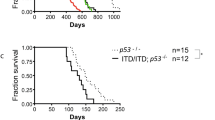Abstract
Recent studies support the potential application of the wt-p53 gene in cancer therapy. Expression of exogenous wt-p53 suppresses a variety of leukaemia phenotypes by acting on cell survival, proliferation and/or differentiation. As for tumour gene therapy, the final fate of the neoplastic cells is one of the most relevant points. We examined the effects of exogenous wt-p53 gene expression in several leukaemia cell lines to identify p53-responsive leukaemia. The temperature-sensitive p53Val135 mutant or the human wt-p53 cDNA was transduced in leukaemia cell lines representative of different acute leukaemia FAB subtypes, including M1 (KG1), M2 (HL-60), M3 (NB4), M5 (U937) and M6 (HEL 92.1.7), as well as blast crisis of chronic myelogenous leukaemia (BC-CML: K562, BV173) showing diverse differentiation features. By morphological, molecular and biochemical analyses, we have shown that exogenous wt-p53 gene expression induces apoptosis only in cells corresponding to M1, M2 and M3 of the FAB classification and in BC-CML showing morphological and cytochemical features of undifferentiated blast cells. In contrast, it promotes differentiation in the others. Interestingly, cell responsiveness was independent of the vector used and the status of the endogenous p53 gene.
Similar content being viewed by others
Author information
Authors and Affiliations
Rights and permissions
About this article
Cite this article
Rizzo, M., Zepparoni, A., Cristofanelli, B. et al. Wt-p53 action in human leukaemia cell lines corresponding to different stages of differentiation. Br J Cancer 77, 1429–1438 (1998). https://doi.org/10.1038/bjc.1998.236
Issue Date:
DOI: https://doi.org/10.1038/bjc.1998.236
- Springer Nature Limited
This article is cited by
-
NFκB regulates p21 expression and controls DNA damage-induced leukemic differentiation
Oncogene (2018)
-
Mechanisms of resistance to apoptosis in the human acute promyelocytic leukemia cell line NB4
Annals of Hematology (2015)
-
PML enhances the regulation of p53 by CK1 in response to DNA damage
Oncogene (2008)
-
8-Hydroxydeoxyguanosine induces senescence-like changes in KG-1, human acute myelocytic leukemia cell line
Biotechnology and Bioprocess Engineering (2007)
-
Correlation analysis of two-dimensional gel electrophoretic protein patterns and biological variables
BMC Bioinformatics (2006)




